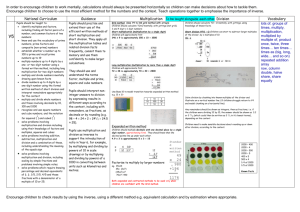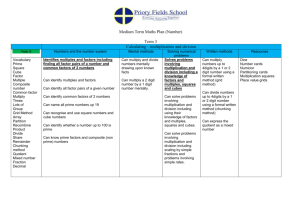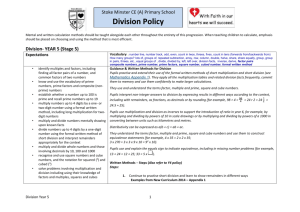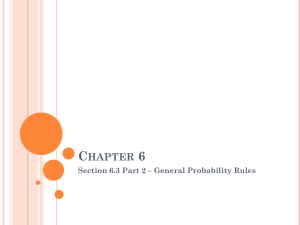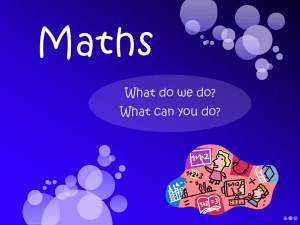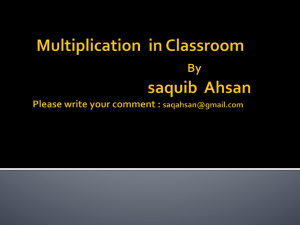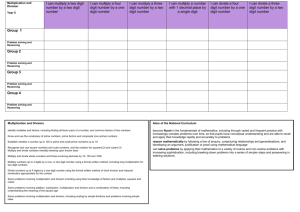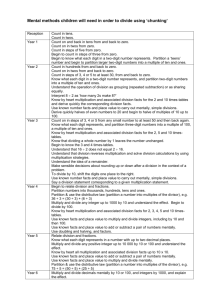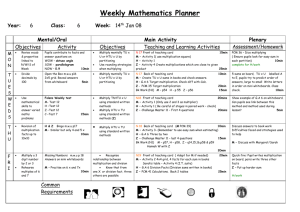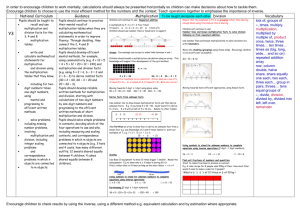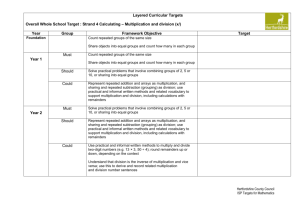EALC Yr5 Multiplication and Division
advertisement
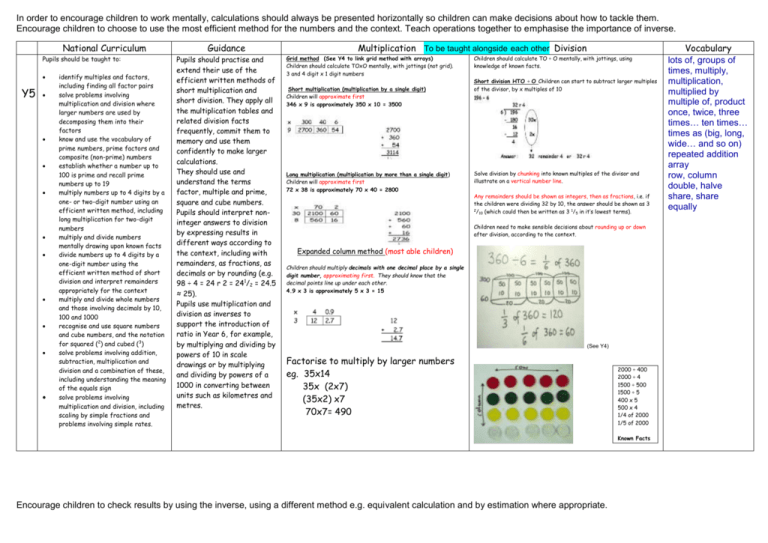
In order to encourage children to work mentally, calculations should always be presented horizontally so children can make decisions about how to tackle them. Encourage children to choose to use the most efficient method for the numbers and the context. Teach operations together to emphasise the importance of inverse. National Curriculum Pupils should be taught to: Y5 identify multiples and factors, including finding all factor pairs solve problems involving multiplication and division where larger numbers are used by decomposing them into their factors know and use the vocabulary of prime numbers, prime factors and composite (non-prime) numbers establish whether a number up to 100 is prime and recall prime numbers up to 19 multiply numbers up to 4 digits by a one- or two-digit number using an efficient written method, including long multiplication for two-digit numbers multiply and divide numbers mentally drawing upon known facts divide numbers up to 4 digits by a one-digit number using the efficient written method of short division and interpret remainders appropriately for the context multiply and divide whole numbers and those involving decimals by 10, 100 and 1000 recognise and use square numbers and cube numbers, and the notation for squared (2) and cubed (3) solve problems involving addition, subtraction, multiplication and division and a combination of these, including understanding the meaning of the equals sign solve problems involving multiplication and division, including scaling by simple fractions and problems involving simple rates. Guidance Pupils should practise and extend their use of the efficient written methods of short multiplication and short division. They apply all the multiplication tables and related division facts frequently, commit them to memory and use them confidently to make larger calculations. They should use and understand the terms factor, multiple and prime, square and cube numbers. Pupils should interpret noninteger answers to division by expressing results in different ways according to the context, including with remainders, as fractions, as decimals or by rounding (e.g. 98 ÷ 4 = 24 r 2 = 241/2 = 24.5 ≈ 25). Pupils use multiplication and division as inverses to support the introduction of ratio in Year 6, for example, by multiplying and dividing by powers of 10 in scale drawings or by multiplying and dividing by powers of a 1000 in converting between units such as kilometres and metres. Multiplication To be taught alongside each other Division Grid method (See Y4 to link grid method with arrays) Children should calculate TOxO mentally, with jottings (not grid). 3 and 4 digit x 1 digit numbers Short multiplication (multiplication by a single digit) Children will approximate first 346 x 9 is approximately 350 x 10 = 3500 Long multiplication (multiplication by more than a single digit) Children will approximate first 72 x 38 is approximately 70 x 40 = 2800 Children should calculate TO ÷ O mentally, with jottings, using knowledge of known facts. Short division HTO ÷ O Children can start to subtract larger multiples of the divisor, by x multiples of 10 Solve division by chunking into known multiples of the divisor and illustrate on a vertical number line. Any remainders should be shown as integers, then as fractions, i.e. if the children were dividing 32 by 10, the answer should be shown as 3 2 /10 (which could then be written as 3 1/5 in it’s lowest terms). Children need to make sensible decisions about rounding up or down after division, according to the context. Expanded column method (most able children) Children should multiply decimals with one decimal place by a single digit number, approximating first. They should know that the decimal points line up under each other. 4.9 x 3 is approximately 5 x 3 = 15 (See Y4) Factorise to multiply by larger numbers eg. 35x14 35x (2x7) (35x2) x7 70x7= 490 2000 ÷ 400 2000 ÷ 4 1500 ÷ 500 1500 ÷ 5 400 x 5 500 x 4 1/4 of 2000 1/5 of 2000 Known Facts Encourage children to check results by using the inverse, using a different method e.g. equivalent calculation and by estimation where appropriate. Vocabulary lots of, groups of times, multiply, multiplication, multiplied by multiple of, product once, twice, three times… ten times… times as (big, long, wide… and so on) repeated addition array row, column double, halve share, share equally
